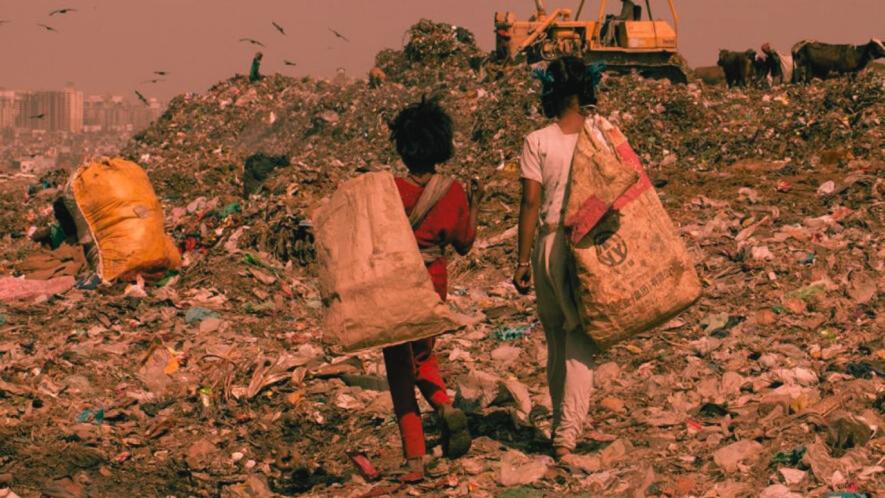Capitalist Poverty Vis-à-Vis Pre-Capitalist Poverty

Representational Image. File Image
Poverty is taken to be a homogeneous phenomenon irrespective of the mode of production that is under consideration. Even reputed economists believe in this homogeneous conception of poverty.
In fact, however, poverty under capitalism is entirely different from poverty in pre-capitalist times. Even if for statistical purposes poverty is defined as lack of access to a set of use-values that are essential for living irrespective of the mode of production, the fact remains that this lack is enmeshed under capitalism within a set of social relationships that are sui generis and different from earlier. Poverty under capitalism thus takes a specific form associated with insecurity and indignity that makes it particularly unbearable.
There are roughly four proximate features of capitalist poverty. The first arises from the inviolability of contracts, which means that irrespective of their conditions, the poor have to pay whatever they are contracted to pay; this leads to a loss of assets or destitution.
In pre-capitalist times, for instance in Mughal India, revenue demand was a proportion of the produce; this meant that in years of poor harvest, the revenue claims on the peasants got automatically scaled down. Put differently, the burden of the poor harvest got shared among the producers and the overlord.
But, in colonial India, reflecting its capitalist ethos, the tax got levied on land; the contract between the producer and the overlord changed: the producer would be allowed to cultivate a plot of land provided he paid a certain amount of revenue to the State. This meant that in a poor harvest year, the burden of the poor harvest was not shared and fell exclusively on the producer. The contract, in other words, was for a fixed amount of money payment, not for a variable amount of payment, as a share of the produce or its equivalent in money form. The destitution of the peasantry, that is, the transfer of peasants’ assets to money lenders followed from this. Poverty, in short, was associated with destitution which, therefore, tended to have a cumulative impact on the producers.
Put differently, the “flow” lack of access to use-values on the part of the producers was accompanied by a process of their “stock” deprivation of assets, which meant an increase in their vulnerability over time. There was thus a dynamic introduced into poverty.
The second feature of capitalist poverty is that it is experienced by individuals, whether individual persons or households. In a pre-capitalist society where people lived in communities, other members of the community, whether belonging to the same caste-group or simply to the same village, came to the help of the poor in particular years of bad harvests or natural calamities. Privations, in other, words were not suffered in isolation.
Under capitalism, however, when the communities are broken up because of the inexorable logic of the system, and the individual emerges as the primary economic category, this individual also suffers privations in isolation.
Non-Marxist traditions in economic theory fail to see this basic change because they are bereft of any sense of history. Marx had accused classical economics of this blindness toward history: the individual that emerged only at a certain point in history, was taken by it as having existed all along.
Neo-classical economics, starting with Carl Menger and Stanley Jevons, which began around 1870, of course apotheosised the individual, taking the individual as an eternal category and its point of departure for economic analysis. Both strands, therefore, missed the contrast between capitalist poverty and pre-capitalist poverty, the former experienced by isolated and alienated individuals and the latter referring only to the deprivation suffered within a community and hence to a sharing of deprivation.
The fact that capitalism is characterised by alienated individuals (until they form “combinations” or trade unions which bring them together in common struggles against the system) and that it is these individuals who experience poverty, gives poverty an additional dimension; it is not just the lack of access to a set of use-values that constitutes capitalist poverty, but also a psychological trauma that goes with this lack of access.
This becomes clearer when we look at the third feature of capitalist poverty. It arises for two reasons: one is the low wages of those employed, and the other is the absence of employment. It is the reserve army of labour that is particularly afflicted by poverty.
In fact, in economies like ours, where the “employed” and the “unemployed” are not two distinct categories, but most workers barring a tiny minority are unemployed for several days in a week or several hours in a day, the psychological trauma associated with poverty arising from the inability to find employment, is all the more pervasive. The lack of employment appears as a personal failure on the part of the individual, as something that saps the individual’s self-worth, apart from causing lack of access to a given set of use-values.
The fourth feature of capitalist poverty is the opacity to those afflicted by it of the factors causing it. Poverty in the sense of a lack of access to a given set of use-values in a pre-capitalist society is palpably rooted in the size of what is produced, and in the share taken from it by the overlord. Indeed, this is visible to everyone: a bad harvest may reduce the size of the produce and hence accentuate poverty (even when the reduction in output is shared); likewise, a rapacious overlord may snatch so much from the producers that many of them are reduced to poverty even in normal harvest years. But why a person remains unemployed and hence poor under capitalist conditions, remains a mystery to the person himself. Likewise, why prices suddenly rise, pushing more people into poverty, remains a mystery to those afflicted.
Satyajit Ray’s film about the 1943 Bengal famine (Distant Thunder) shows, in the run-up to the famine, prices rising in Bengal even as the Japanese troops occupy Singapore. The war in Ukraine today certainly contributes to the world-wide rise in food prices that accentuates poverty even in a remote African or Indian village. The apparent opacity of the roots of capitalist poverty is linked to the phenomenon of global inter-connectedness under capitalism; that is, to the fact that global developments, developments in distant lands, have an impact on every village, no matter how remote.
These specific features of capitalist poverty have important implications, of which I shall draw attention to only one. Many well-intentioned persons, who would like to reduce or eliminate poverty, suggest that transfers from the government budget should be made, so that everybody in society has a basic minimum income. This, of course, has not happened on the requisite scale anywhere, so that poverty continues as a social phenomenon and is even getting accentuated because of the world-wide food price inflation alongside the recession caused by neo-liberal capitalism. Even suggestions for transfers are invariably for somewhat paltry transfers. But all this refers to poverty in the sense of inadequate access to a set of use-values, that is, poverty that does not refer specifically to capitalist poverty.
Even if sufficient transfers could be made and poverty in the sense of lack of access to use-values could be overcome, that still would not overcome capitalist poverty which also entails a psychological trauma, a robbing of self-worth through unemployment.
Overcoming capitalist poverty in this true sense requires inter alia the provision of universal employment. Keynes had thought that this could be done under capitalism, but he has been proved wrong. This is not to suggest that transfers should not be made; but they are simply insufficient, palliatives that do not go to the root of the problem.
In India, likewise, 5 kilogrammes of free foodgrains per head per month are currently being provided to about 80 crore beneficiaries. How much of this reaches them, how long this scheme will continue (it was started because of the pandemic) are moot points. But anyone who believes that schemes like this constitute the panacea for poverty in contemporary India is sadly mistaken.
What is required is the universal provision of employment, education, healthcare, old-age security, and food, that would restore to people the dignity of being citizens of a democratic society; but this would involve going beyond neo-liberal capitalism.
Get the latest reports & analysis with people's perspective on Protests, movements & deep analytical videos, discussions of the current affairs in your Telegram app. Subscribe to NewsClick's Telegram channel & get Real-Time updates on stories, as they get published on our website.
























